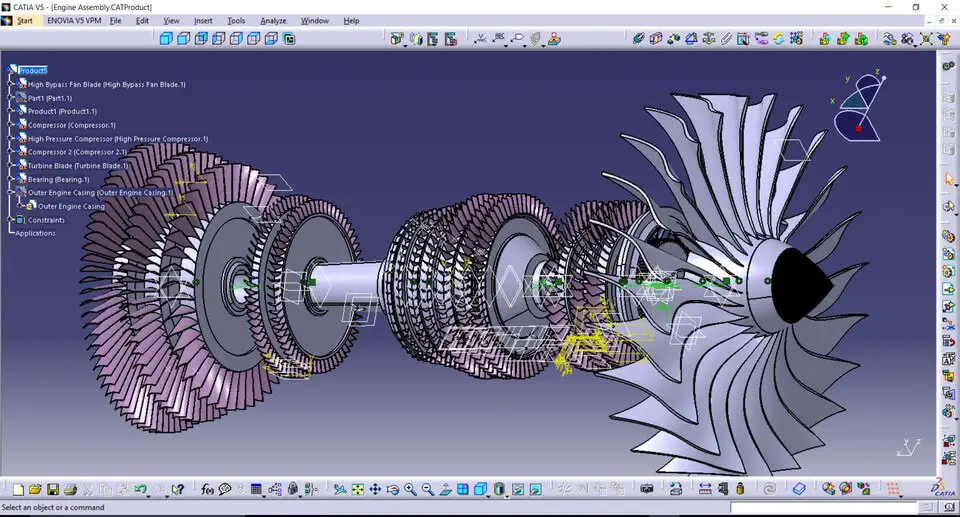When it comes to aeronautical design, choosing the right tool can significantly impact the accuracy, efficiency, and success of your project. Among the leading software options, CATIA and SolidWorks stand out for their robust capabilities and widespread industry use. While both tools are developed by Dassault Systèmes, they cater to different engineering needs and project scales. Understanding their differences can help you make an informed decision tailored to your aeronautical design requirements.
CATIA: Advanced Capabilities for Complex Aerospace Projects
CATIA is renowned for its advanced capabilities in handling complex and large-scale aerospace projects. It is the preferred choice for major aircraft manufacturers and is used extensively in the aerospace and defense industries.
Key Features of CATIA:
- Comprehensive 3D Modeling and Simulation: CATIA offers comprehensive solutions for 3D modeling, simulation, and digital mock-ups.
- Multi-Platform Integration: Its multi-platform integration allows engineers to collaborate across different departments seamlessly.
- High-Performance Assembly Management: CATIA manages intricate assemblies with thousands of components without performance degradation, making it ideal for designing aircraft structures and engine components.
- Advanced Analysis Tools: With powerful tools for computational fluid dynamics (CFD) and finite element analysis (FEA), CATIA ensures precise simulation of real-world aerodynamic conditions.
- Model-Based Systems Engineering (MBSE): Supports the integration of mechanical, electrical, and fluid systems into a cohesive design.
Limitations of CATIA:
Despite its advanced capabilities, CATIA’s complexity and high cost may pose challenges for smaller firms or academic institutions.
SolidWorks: User-Friendly and Cost-Effective for Aeronautical Prototyping
SolidWorks is known for its user-friendly interface and cost-effective solutions without compromising on functionality. It is widely adopted by small to mid-sized engineering firms for aeronautical prototyping and component design.
Key Features of SolidWorks:
- Intuitive Design Environment: SolidWorks provides a robust suite of design tools, including parametric modeling, motion analysis, and structural simulation.
- Rapid Prototyping Support: Integrates seamlessly with manufacturing processes like 3D printing and CNC machining, making it excellent for rapid prototyping.
- Broad Compatibility: Supports a wide range of file formats, ensuring compatibility with various engineering and manufacturing processes.
- Simulation Capabilities: Allows engineers to analyze stress, vibration, and thermal dynamics, crucial for ensuring the safety and performance of aircraft parts.
- Cost-Effective Solution: Its affordability and ease of use make it attractive for educational purposes and smaller-scale aerospace projects.
Limitations of SolidWorks:
While it excels in usability and cost-efficiency, SolidWorks lacks the advanced systems integration and large-scale management capabilities found in CATIA.
Choosing the Right Tool for Your Aeronautical Design Needs
When deciding between CATIA and SolidWorks for aeronautical design, consider the scale and complexity of your project. Each tool offers distinct advantages tailored to different engineering contexts.
When to Choose CATIA:
- Large, multidisciplinary aerospace systems requiring high precision.
- Projects demanding advanced simulation and real-world aerodynamic analysis.
- Enterprises requiring multi-department collaboration and model-based systems engineering.
When to Choose SolidWorks:
- Smaller-scale aeronautical designs and prototyping.
- Rapid development cycles with a need for quick iteration and testing.
- Educational environments and mid-sized firms seeking cost-effective solutions.
Staying Competitive in the Evolving Aeronautical Industry
Both CATIA and SolidWorks offer extensive support and regular updates, ensuring they stay at the forefront of technological advancements. Your choice ultimately depends on the specific demands of your aeronautical design project, your team’s expertise, and your budget.
Stay informed about the latest aeronautical design tools and industry innovations at epci.ng to enhance your engineering capabilities.
